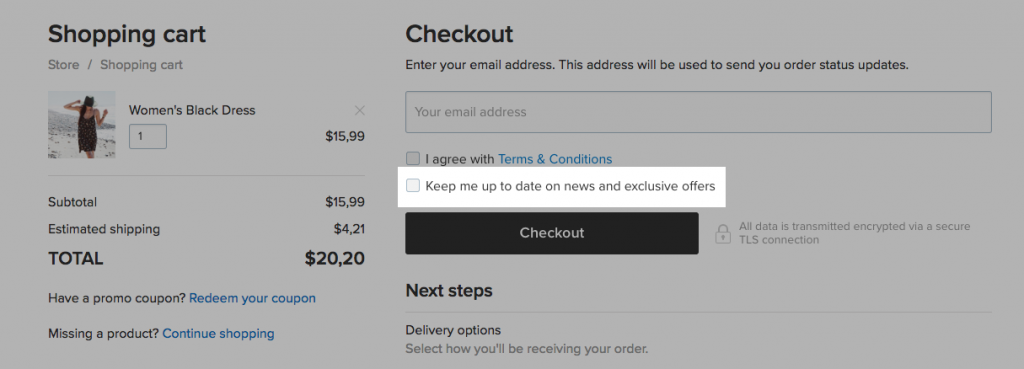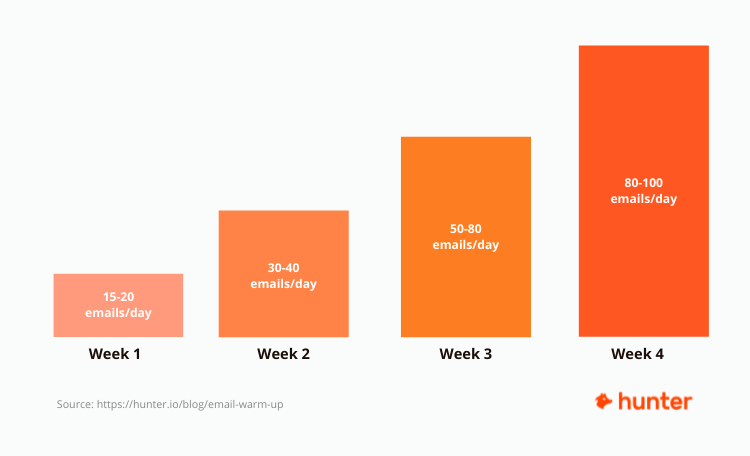Benjaminas Franklinas pradėjo leisti vargšų Richardo almanachą 1734 m., siekdamas reklamuoti savo spausdinimo verslą. Jis skelbė smulkmenas, išmintį, orų pranešimus ir praktiškai viską, ką žmonės tuo metu rado naudingo. Franklinas galiausiai pardavė 10,000 XNUMX kopijų per metus. Tai buvo pirmas kartas, kai informaciniai biuleteniai buvo naudojami turinio rinkodarai ir prekės ženklo reklamai.
Naujienlaiškiai veikė dar 1734 m. ir toliau veikia 2022 m. Jie ypač naudingi el. prekybos įmonėms. El. prekybos naujienlaiškis padeda klientams informuoti apie naujus produktus ir įmonės naujienas, todėl gavėjai pirmiausia galvoja apie jūsų verslą, kai jiems ko nors reikia. Tačiau elektroninės prekybos naujienlaiškiai yra ne tik veiksmingi švino kartos įrankiai (dar žinomi kaip potencialių pirkėjų pritraukimas).
- 59% pirkėjų daro įtaką rinkodaros el Pardavimo ciklas.
- 4.14 milijardo žmonių kasdien tikrina savo el. paštą. El. pašto rinkodaros pajamos kitais metais viršys 10 milijardų dolerių, kaip teigia Statista.
Persotintoje rinkoje, kurioje el. prekybos prekės ženklai stengiasi patraukti vartotojų dėmesį, informaciniai biuleteniai tapo veiksmingu būdu didinti lojalumą prekės ženklui neišleidžiant milijonų. Tačiau elektroninės prekybos naujienlaiškių sėkmė labai priklauso nuo vartotojų skaičiaus iš tikrųjų gauna juos į savo pašto dėžutes.
Kas yra el. pašto pristatymas?
El. pašto pristatymas – tai galimybė pasiekti prenumeratorių gautuosius. Čia neatsižvelgiama į el. laiškų, patenkančių į šlamšto aplanką arba atmestų gavėjo serverio, skaičių.
Jei išsiųsite naujienlaiškį 100 prenumeratorių, galite pamatyti, kad jis pasiekė tik 90 gautųjų. Mažas el. pašto pristatymas reiškia mažesnį įsitraukimą, daugiau pranešimų apie šlamštą ir didelį procentą el. laiškų, kurie nepasiekė gavėjų. Prastas el. pašto pristatymas turi įtakos ne tik greitis, kuriuo žmonės atidaro naujienlaiškius, bet taip pat kelia pavojų svarbiems perspėjimams apie operaciją, pvz., el. laiškams, pranešantiems klientams apie užsakymo ir mokėjimo būsenos atnaujinimus.
Kalbant apie el. pašto pristatymą, žemi atidarymo rodikliai ir įtraukimas yra aiškus signalas interneto paslaugų teikėjams, kad gavėjai nesidomi jūsų turiniu. Dėl mažo įsitraukimo paslaugų teikėjai netgi gali blokuoti jūsų el. pašto kampanijas.
Kaip matote, el. pašto pristatymas yra pirmas dalykas, kurį el. prekybos savininkai turi stebėti pašto rinkodaros pastangos.
Kaip stebėti savo informacinių biuletenių pristatymą?
Pradėkime nuo

Jei norite gauti daugiau įžvalgų, kad suprastumėte savo padėtį, taip pat galite peržiūrėti šiuos įrankius, kuriuose siūlomas nemokamas planas arba gausus nemokamas bandomasis laikotarpis:
- MailTester: MailTester siūlo gana daug nemokamai. Ji analizuoja jūsų el. laiškus, kad nustatytų jų kokybę, ir siūlo sprendimus, kaip pagerinti jūsų rezultatą. Naudodami mokamą versiją galite integruoti ataskaitą į savo el. pašto teikėjo paslaugas ir turėti įsigytų testų sąrašą.
- „MXToolbox“: Jei ieškote daugiau
turtingas turinys el. pašto pristatymo įrankis, MXToolbox gali būti atsakymas. Ji tikrina saugos protokolus ir dalijasi įspėjimais apie reputacijos pasikeitimą bei abonentų geografinę vietą. - glockapps: „GlockApps“ yra patikimas pristatymo įrankis, kuris tikrina pradinio sąrašo paskyrų autentifikavimą, šlamšto balą ir IP reputaciją (bandomieji el. pašto adresai, sukurti siekiant stebėti, kur bus išsiųsti pranešimai.) Taip pat galite pamatyti, ar naujienlaiškiai pasiekia gautuosius. , reklaminius, socialinius ar šlamšto aplankus. Naudodami „GlockApps Bounce Monitor“ galite patikrinti el. laiškų atmetimo rodiklį (dar žinomą kaip nepavykusių pristatymų procentas).
Dabar, kai žinote būdus, kaip patikrinti el. prekybos naujienlaiškio pristatymą, laikas išsiaiškinti, ar jūsų kampanijų sėkmė.
Ar jūsų el. pašto pristatymas tinkamas?
Idealiu atveju norite pasiekti 100 % prenumeratorių 100 % laiko. Tačiau realybė dažnai nuvilia. Pagal 2021 m. spalio mėn. „EmailToolTester“ ataskaitos leidimas:
- Vidutinis pagrindinių el. pašto įrankių pristatymas yra 85.3%. Taigi, jei jūsų pristatymas viršija 90%, esate geroje vietoje.
- Pristatymas kiekvienais metais šiek tiek keičiasi, todėl sutelkite dėmesį į nuoseklumą.
- El. prekybos pramonėje vidutinis griežto atmetimo rodiklis (kai el. laiškas grąžinamas siuntėjui, nes gavėjo el. pašto adresas neteisingas) yra 0.19 %, o vidutinis atmetimo rodiklis (nurodo laikiną pristatymo problemą) – 0.26 %. Kad el. pašto kampanija būtų efektyvi, įsitikinkite, kad esate žemiau šių skaičių.
Kaip pagerinti el. pašto pristatymą?
Jei el. pašto pristatymas nėra toks, kokio norite, tai gali būti dėl turinio ar techninės problemos. Laimei, keletą pakeitimų galite pagerinti savo skaičius.
Išvalykite savo el. pašto sąrašą
Daug verslo savininkų perka
Visada turėtumėte pabandyti sudaryti prenumeratorių sąrašą per

Net jei sukūrėte savo sąrašą, daugelis ankstesnių klientų po kurio laiko nustos atidaryti jūsų el. laiškus. Turite arba atsikratyti neaktyvių adresų, arba atsiųsti patvirtinimo el. laišką. Tai el. laiškas, kuriuo klientams primenama apie jūsų verslą ir prašoma patvirtinti, kad domisi jūsų naujienlaiškiais.
Periodiškai naudokite an el. pašto tikrinimo įrankis kad apkarpytumėte sąrašą ir jį nuolat atnaujintumėte. Jei to nepadarysite, padidės atmetimo rodiklis, kuris yra raudona vėliavėlė gavėjo el. pašto paslaugų teikėjui (ESP). Laikui bėgant gausite žemą siuntėjo balą, kuris iš esmės yra jūsų el. pašto kampanijų kredito balas. Kai jis yra per mažas, el. pašto paslaugų teikėjai gali nukreipti jūsų el. laiškus į šiukšlių aplankus.
Kalbant apie el. prekybos informacinius biuletenius, įsitraukusi auditorija yra daug geriau nei daug neaktyvių gavėjų.
Lengvai atsisakykite prenumeratos
Su pokalbiu apie GDPR (Bendrąjį duomenų apsaugos reglamentą) ir vartotojų privatumas stiprėja, dvigubai
Net jei jūsų prenumeratoriai patvirtina savo el. laiškus, tai nereiškia, kad jie nori likti jūsų sąraše amžinai. Štai kodėl turite leisti jiems lengvai atsisakyti jūsų sąrašo prenumeratos. Vienas iš būdų tai padaryti – prie kiekvieno naujienlaiškio pridėti nuorodą Atsisakyti prenumeratos:

Jei sąmoningai apsunkinsite pasitraukimą iš el. pašto sąrašo, žmonės gali perkelti jūsų naujienlaiškį į šlamšto aplanką, kad išvengtų su juo sąveikos. Gavus daug pranešimų apie šlamštą, ESP gali užblokuoti arba laikinai sustabdyti paskyrą.
Jei apsistosite ilgiau, galite visam laikui sugadinti santykius su klientais, todėl būtinai parodykite, kad norite padėti savo auditorijai. Pagyros iš lūpų į lūpas padidins lojalumą prekės ženklui, o jūs norite atrodyti lankstūs ir supratingi, o ne šlamštas.
Suasmeninkite savo el. laiškus aukštu lygiu
El. paštas yra unikalus tuo, kad siūlo išsamų, asmeninį pokalbį tarp prekių ženklų ir klientų. Sutelkti dėmesį į statybą

Šiltas ir draugiškas požiūris kartu su labai suasmenintu turiniu pritrauks daug klientų ir ištrauks jus iš pristatymo bėdų.
Venkite šiukšlių gaudyklių
Šlamšto spąstai yra interneto paslaugų teikėjo būdas apsaugoti vartotojus. Šie masalai skirti sugauti nepageidaujamo e. pašto platintojus, tačiau gali atsitiktinai sugauti teisėtus rinkodaros specialistus.
ESP naudos netikrus el. pašto adresus kaip spąstus. Šie adresai nėra susieti su jokiu tikru asmeniu, parašyti neteisingai, neaktyvūs arba perdirbti, o tai reiškia, kad ESP paima anksčiau aktyvią paskyrą ir pakartotinai naudoja ją spąstais. Kai išsiunčiate el. laišką į vieną iš šių paskyrų, jūsų pristatymas patiria didžiulį smūgį. Šlamšto spąstai veda į juoduosius sąrašus, o juodieji sąrašai veda prie elektroninės prekybos naujienlaiškių mirties.
Štai kodėl turėtumėte naudoti dvigubą
Susiję: Kas atsitiks, jei atidarysite el. pašto šiukšles
Greita pastaba: jei norite pridėti vaizdo įrašą prie savo el. laiško, visada geriau įterpti vaizdo įrašą. Išskleidus vaizdo įrašų nuorodas arba naudojant HTML kodus, naujienlaiškiai gali būti pažymėti kaip šlamštas.
Rašyti Ne šlamštas Dalyko eilutės
Nėra prasmės rašyti žavingą el. pašto kopiją, jei neskiriate tiek daug (ar net daugiau) laiko temos eilutės ir antraštės teksto rašymui. Štai keletas patarimų, kaip rašyti
- Sutelkite dėmesį į tikros vertės suteikimą skaitytojams iš anksto.
- naudojimas
dėmesio pritraukimas skaitytojo asmenybei artimos eilutės. - Naudokite pavadinimus arba atpažįstamas nuorodas, kad padidintumėte aktualumą.
- Nenaudokite perdėjimo, kad sulauktumėte paspaudimų. Skaitytojai, kurie jaučiasi apgauti, pažymės jūsų el. paštą kaip šlamštą.
Skirkite šiek tiek laiko ir sužinokite El. pašto gedimai, kurių reikia vengti.
Apsaugokite savo siuntėjo reputaciją
Ši dalis skirta labiau techniškiems vartotojams, bet manome, kad apie tai labai svarbu pagalvoti visiems el. prekybos pardavėjams. Siuntėjo reputacijos balas įvertina siuntėjo adreso reputaciją skalėje nuo 0 iki 100. Tai yra skėtinė metrika, pagal kurią atsižvelgiama į daugelį jūsų el. pašto kampanijų aspektų, įskaitant atmetimo rodiklį, skundus dėl nepageidaujamo pašto, šiukšlių gaudykles, atvirą ir
Reputacijos balas taip pat priklauso nuo jūsų el. pašto kiekio nuoseklumo. Staigus padidėjimas arba sumažėjimas gali įspėti ESP apie jūsų el. Jei tik pradedate veiklą, laikui bėgant palaipsniui didinkite siunčiamų el. laiškų skaičių, kaip parodyta toliau pateiktame paveikslėlyje, kad atrodytumėte kaip teisėtas verslas:

Galiausiai naudokite autentifikavimo protokolus. Sender Policy Framework (SPF) patvirtina siuntėjo IP adresą, o DomainKeys Identified Mail (DKIM) tikrina siunčiamo el. laiško nuosavybės teisę. Šiuos protokolus lengva nustatyti, net jei savęs nemanote
Pirkti šį trumpą vadovą kaip įrodyti savo tapatybę ir apsaugoti el. pašto paskyrą vos keliais paspaudimais.
Sumavimas
El. laiškus turėtumėte naudoti kurdami savo prekės ženklą, tik jei žinote, kad naujienlaiškiai pristatomi tinkamai ir efektyviai. Norėdami pagerinti el. prekybos naujienlaiškių pristatymą, kurkite el. laiškus, kuriuos verta atidaryti. Laikykitės nuoseklios strategijos ir kurkite asmeninius poreikius. Sekite Benjamino Franklino pėdomis kurdami puikų informacinį biuletenį ir jums tikrai pasiseks!
- Kas yra el. pašto rinkodara ir jos pranašumai
- Kaip parašyti pasisveikinimo laišką, kuris parduoda
- Kas yra el. pašto rinkodaros kanalas
- 10 Evergreen protingų būdų išplėsti savo naujienlaiškių sąrašą
- Kaip siųsti aktyviuosius el. laiškus, kad klientai sugrįžtų
- Kaip padidinti savo pajamas naudojant naujienlaiškių segmentavimą
- El. prekybos el. pašto rinkodaros geriausia praktika iki 3 kartų pardavimo
- 5 el. pašto gedimai, kurių reikia vengti
- Kaip el. laiškuose atspindėti savo prekės ženklo asmenybę
- Kaip pagerinti el. prekybos informacinio biuletenio pristatymą
- Geriausios profesionalios el. pašto adresų idėjos
- Geriausia el. prekybos rinkodaros paslauga el. paštu
- Geriausia el. prekybos el. pašto rinkodaros programinė įranga
- Geriausi ir privalomi el. pašto rinkodaros šablonai
- El. pašto rinkodaros etalonai









